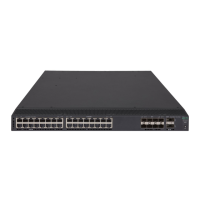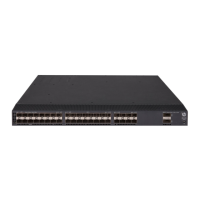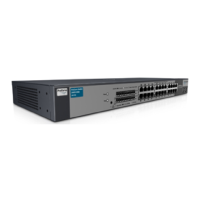7
Step Command Remarks
1. Enter system view.
system-view
N/A
2. Create a RIP process for a
VPN instance and enter RIP
view.
rip
[ process-id ]
vpn-instance
vpn-instance-name
Perform this configuration on the
MCE. On a VPN site, create a
common RIP process.
3. Enable RIP on the interface
attached to the specified
network.
network
network-address
By default, RIP is disabled on an
interface.
4. Redistribute remote site
routes advertised by the PE
into RIP.
import-route
protocol
[
process-id
] [
allow-ibgp
] [
cost
cost
|
tag
tag ] *
By default, no route is
redistributed into RIP.
5. (Optional.) Configure the
default cost value for the
redistributed routes.
default cost
value
The default cost is 0.
Configuring OSPF between an MCE and a VPN site
An OSPF process belongs to the public network or a single VPN instance. If you create an OSPF
process without binding it to a VPN instance, the process belongs to the public network.
Binding OSPF processes to VPN instances can isolate routes of different VPNs. For more
information about OSPF, see Layer 3—IP Routing Configuration Guide.
To configure OSPF between an MCE and a VPN site:
Step Command Remarks
1. Enter system view.
system-view
N/A
2. Create an OSPF process for
a VPN instance and enter
OSPF view.
ospf
[ process-id |
router-id
router-id |
vpn-instance
vpn-instance-name ] *
Perform this configuration on the
MCE. On a VPN site, create a
common OSPF process.
An OSPF process bound to a VPN
instance does not use the public
network router ID configured in
system view. Therefore, configure
a router ID for the OSPF process.
An OSPF process can belong to
only one VPN instance, but one
VPN instance can use multiple
OSPF processes to advertise
VPN routes.
3. (Optional.) Configure the
OSPF domain ID.
domain-id
domain-id
[
secondary
]
The default domain ID is 0.
Perform this configuration on the
MCE.
All OSPF processes of the same
VPN must be configured with the
same OSPF domain ID to ensure
correct route advertisement.
4. (Optional.) Configure the
type codes of OSPF
extended community
attributes.
ext-community-type
{
domain-id
type-code1 |
router-id
type-code2
|
route-type
type-code3 }
The defaults are as follows:
• 0x0005 for Domain ID.
• 0x0107 for Router ID.
• 0x0306 for Route Type.
5. (Optional.) Configure the
external route tag for
imported VPN routes.
route-tag
tag-value
By default, no route tag is
configured.
In some networks, a VPN might
be connected to multiple MCEs.

